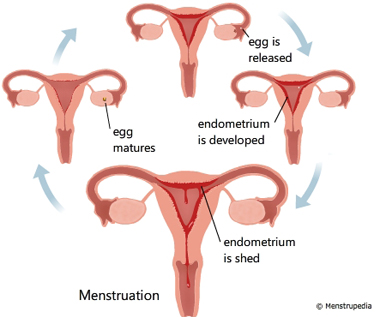What is menstruation?
Every month a sexually mature female's ovary releases an egg cell that travels towards the uterus through the Fallopian tube. The uterus prepares for a possible pregnancy by developing a uterine lining made of tissue and blood vessels. This lining is called endometrium.
If the egg is not fertilized and pregnancy does not occur, the uterine lining is shed and it exits the body through the vagina as a mixture of blood and tissue over a course of 3 to 7 days. This is called menstruation (pronounced: mens-troo-A-shun) or a period. The cycle starts over again with an egg that begins to mature in one of the ovaries. This cycle is called menstrual cycle and is generally 25 to 35 days long.

References:
- Normal Menstrual Cycle, http://www.emedicinehealth.com
- All About Menstruation, http://teens.webmd.com
- Menstrual cycle: What's normal, what's not, http://www.mayoclinic.com



